
Advanced Search
Submit Manuscript
Advanced Search
Submit Manuscript
Volume 33, No 7, Jul 2023
ISSN: 1001-0602
EISSN: 1748-7838 2018
impact factor 17.848*
(Clarivate Analytics, 2019)
Volume 33 Issue 7, July 2023: 533-545 |
Structure and transport mechanism of the human calcium pump SPCA1
Mengqi Wu1,† , Cang Wu1,† , Tiefeng Song2,† , Kewu Pan3 , Yong Wang2,4,* , Zhongmin Liu1,*
1Department of Immunology and Microbiology, School of Life Sciences, Southern University of Science and Technology, Shenzhen, Guangdong, ChinaSecretory-pathway Ca2+-ATPases (SPCAs) play critical roles in maintaining Ca2+ homeostasis, but the exact mechanism of SPCAs-mediated Ca2+ transport remains unclear. Here, we determined six cryo-electron microscopy (cryo-EM) structures of human SPCA1 (hSPCA1) in a series of intermediate states, revealing a near-complete conformational cycle. With the aid of molecular dynamics simulations, these structures offer a clear structural basis for Ca2+ entry and release in hSPCA1. We found that hSPCA1 undergoes unique conformational changes during ATP binding and phosphorylation compared to other well-studied P-type II ATPases. In addition, we observed a conformational distortion of the Ca2+-binding site induced by the separation of transmembrane helices 4L and 6, unveiling a distinct Ca2+ release mechanism. Particularly, we determined a structure of the long-sought CaE2P state of P-type IIA ATPases, providing valuable insights into the Ca2+ transport cycle. Together, these findings enhance our understanding of Ca2+ transport by hSPCA1 and broaden our knowledge of P-type ATPases.
https://doi.org/10.1038/s41422-023-00827-x